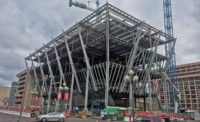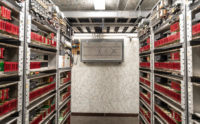
Construction is picking up in the health-care market, but renovations trump new building and raising capital is becoming more difficult. Unlike the boom decade of hospital construction prior to 2008, hospitals are now more constrained in their spending habits. Nonetheless, significant projects are under way, and interest in the health-care sector is growing.
The American Society of Healthcare Engineering says its latest survey, published in November 2010, reported that 26% of respondents had hospital projects currently under construction compared to 31% in 2009.
ASHE Executive Director Dale Woodin says, “We saw a lessening of construction from 2009 to 2010, with construction picking up on a limited basis in 2010. I expect a continuation of that trend.”
The La Jolla campus of the University of California San Diego Health System (UCSDHS) is bristling with building activity, with more than $1 billion in construction under way. The $663.8-million Jacobs Medical Center, a 10-story, 509,500- sq-ft addition to the La Jolla campus, “is the biggest construction project in [UCSDHS] history,” says Shawn Sheffield, chief strategy and business officer for the health system. The project will add 245 beds, doubling the center's size, by 2016. “This project has set us apart because of the size and scope of the hospital,” she says.
The medical center will include three hospitals: a hospital for advanced surgery, a cancer center, and a women's and infants' hospital. Other projects include the $280-million Clinical Translational Research Institute, also under construction, and the $200-million Sulpizio Cardiovascular Center, which recently opened its doors.
Kitchell Contractors, Phoenix, is UCSDHS's construction manager/general contractor for the project. The firm is using a version of integrated project delivery fashioned for public institutions and their unique purchasing/contracting requirements. “We are approximately 60% through [hiring] the many trade contractors on the project,” says Jim Cleaton, project director for the Jacobs Medical Center.
While the high level of construction indicates an owner's market, Sheffield says securing funding for expensive hospital projects is becoming more difficult. “We have historically had a large reliance on philanthropy, but that is getting harder.”
Further, health-care facility owners say construction funded by the American Recovery and Reinvestment Act, which is providing $2 billion in grants to more than 1,500 health centers nationwide, largely has run out. “This has forced us to look at how to grow business and volumes locally,” Sheffield says. “To fill the medical center's new bed tower, we will have to look beyond San Diego and consider how to affiliate with other … systems.”
However, strong activity is also evident at the North Shore-Long Island Jewish Health System (NS-LIJHS). The hospital, now in the second year of a five-year capital plan approaching $2.5 billion, is completing construction of the $40-million, 48,500-sq-ft Katz Women's Hospital Pavilion, scheduled to open in January at the Long Island Jewish Medical Center (LIJMC). The $121.5-million expansion of the 130,000-sq-ft Cohen Children's Medical Center, part of LIJMC campus in New Hyde Park, N.Y., will include construction of a new emergency-room department, an intensive-care unit and surgical suites. It also is spending $73 million to replace older portions of Zucker Hillside Hospital, a 114-bed psychiatric facility.
At the North Shore University West Wing, the NS-LIJHS is spending $400 million to add 16 replacement operating rooms and 44 intensive-care beds, with enough space to install interoperative imaging technology and robotics.




Post a comment to this article
Report Abusive Comment